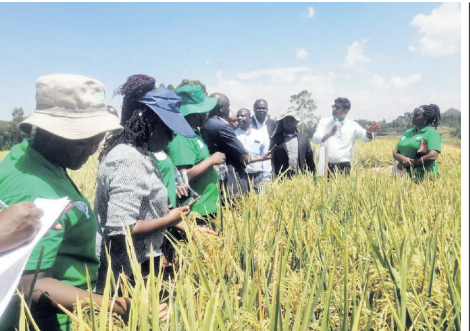

Researchers from the Kenya Agricultural and Livestock Research Organization, in collaboration with the
International Rice Research Institute,
have introduced two rice varieties.
The two are designed to enhance Kenya’s rice production and reduce the country’s heavy reliance on imports.
The newly released Kalimara (CSR36) and Kalpaa (08FAN10) rice varieties are tailored to meet the challenges posed by climate change and soil salinity while meeting the growing consumer demand for high-quality, locally grown rice.
Kalro’s director general Dr Eliud Kireger said the Kalimara and Kalpaa rice varieties were developed through a partnership with the IRRI. These high-yielding, climate-smart varieties are set to significantly contribute to Kenya’s agricultural sector.
“Kalimara is a resilient variety ideal for saline-sodic soils, which are characterised by high salt levels and high alkalinity, with pH values between 9.6 and 9.8 and electrical conductivity ranging from 6 to 10 dS/m,” explained Kireger.
“It matures in 120–125 days, yielding 5 to 5.5 tonnes per hectare under saline conditions, and up to 6.5 tonnes per hectare in normal conditions. Its long, slender, aromatic grains are well-suited to Kenyan consumer preferences.”
On the other hand, the Kalpaa variety matures in just 85 days, this is 20 days faster than the popular Komboka variety. It yields between 6.5 to seven tonnes per hectare.
While it may lack aroma, Kalpaa is highly regarded for its soft texture and non-sticky quality when cooked, making it a suitable choice for local consumers.
“These new varieties address the demand for long, slender, non-sticky rice, which has traditionally been a key driver of rice imports,” Kireger said.
He added that their widespread adoption could significantly reduce Kenya’s rice import bill.
Kireger spoke during the official handover of machinery, equipment and digital devices to Kalro by IRRI for research purposes.
He noted that Kenya imports about 80 per cent of the rice consumed, while local production is just under 20 per cent.
National rice production stands at approximately 250,000 tonnes, whereas consumption exceeds a million tonnes annually.
“There is a huge deficit in rice production,” Kireger said. “To bridge this gap, we need to expand the area under rice cultivation and increase productivity in the existing rice-growing regions.”
To enhance productivity, Kireger pointed out the need for mechanisation and the use of certified quality seeds. Kalro, in collaboration with IRRI, is offering these new varieties to farmers for seed multiplication this season.
Kireger also pointed out the importance of digitisation in improving agricultural practices, stating that it would make it easier for farmers to collect, store and analyse production data.
“As a research organisation, we are committed to increasing both the quantity and quality of rice available to farmers,” he said.
IRRI’s Regional Representative for Africa Dr Abdelbagi Ismail, noted that modernisation is key to improving productivity.
Drawing from India’s experience, Ismail said the country was once in a similar situation to Kenya, heavily reliant on rice imports.
However, after modernising its agricultural system and developing high-yield varieties, India is now the world’s largest rice exporter, with an annual export of over 26 million tonnes.
“Mechanisation can triple productivity and significantly cut costs,” Ismail said.
“With mechanised operations, farmers can grow large areas and have multiple crops per year, possibly even three crops in some areas. This transformation is vital for the future of agriculture in Kenya.”
Ismail added that mechanisation also benefits farm labourers, particularly women, who often do the most strenuous work.
“Mechanisation saves resources and reduces the physical strain on workers. A single farmer can manage hundreds of hectares with the right equipment, which is a game-changer for agriculture in Kenya and across Africa,” he said.
IRRI has been instrumental in supporting this transformation through the Crop to End Hunger initiative. As part of the initiative, IRRI has provided Kalro with advanced machinery, including a 75-horsepower New Holland tractor, a laser leveler, a rotavator, mobile threshers, dryers, and digital devices.
The equipment worth Sh35 million,
will be distributed across Kalro’s regional centers in Embu, Kitale, Katumani, Kakamega, Kibos, Njoro and
Tigoni.










